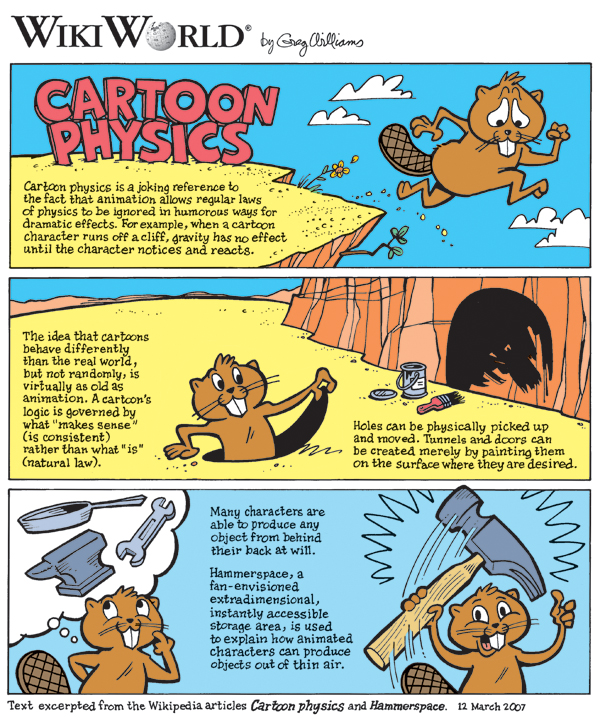|
Steal Wool
''Steal Wool'' is a 1957 Warner Bros. ''Looney Tunes'' cartoon directed by Chuck Jones. The short was released on June 8, 1957, and stars Ralph Wolf and Sam Sheepdog. Mel Blanc provided for the voices of all the characters in this cartoon; however, like all Ralph Wolf and Sam Sheepdog shorts, this short is mostly composed of visual gags. This is the fourth short featuring Ralph Wolf and Sam Sheepdog. The title is a play on steel wool. Plot Like all Ralph Wolf and Sam Sheepdog shorts, this one revolves around Ralph Wolf trying to steal the sheep which Sam Sheepdog is guarding. Sam wakes up to his alarm and presses it harshly before it goes back to its original position. As he is leaving the house with his lunch box, he tosses a newspaper in front of Ralph's door and he comes out eating a doughnut. The two co-workers cordially bid each other good morning. 1. Ralph's first plan is to sneak under a sheep and carry it off, wearing it as a disguise. When Ralph is caught by Sam, he at ... [...More Info...] [...Related Items...] OR: [Wikipedia] [Google] [Baidu] |
Chuck Jones
Charles Martin Jones (September 21, 1912 – February 22, 2002) was an American animator, director, and painter, best known for his work with Warner Bros. Cartoons on the ''Looney Tunes'' and ''Merrie Melodies'' series of shorts. He wrote, produced, and/or directed many classic animated cartoon, Animated Cartoon shorts starring Bugs Bunny, Daffy Duck, Wile E. Coyote and the Road Runner, Pepé Le Pew, and Porky Pig, among others. Jones started his career in 1933 alongside Tex Avery, Friz Freleng, Bob Clampett, and Robert McKimson at the Leon Schlesinger Production's Termite Terrace studio, where they created and developed the Looney Tunes characters. During the World War II, Second World War, Jones directed many of the ''Private Snafu'' (1943–1946) shorts which were shown to members of the United States military. After his career at Warner Bros. ended in 1962, Jones started MGM Animation/Visual Arts, Sib Tower 12 Productions and began producing cartoons for Metro-Goldwyn-Mayer, ... [...More Info...] [...Related Items...] OR: [Wikipedia] [Google] [Baidu] |
Accordion
Accordions (from 19th-century German ''Akkordeon'', from ''Akkord''—"musical chord, concord of sounds") are a family of box-shaped musical instruments of the bellows-driven free-reed aerophone type (producing sound as air flows past a reed in a frame), colloquially referred to as a squeezebox. A person who plays the accordion is called an accordionist. The concertina , harmoneon and bandoneón are related. The harmonium and American reed organ are in the same family, but are typically larger than an accordion and sit on a surface or the floor. The accordion is played by compressing or expanding the bellows while pressing buttons or keys, causing ''pallets'' to open, which allow air to flow across strips of brass or steel, called '' reeds''. These vibrate to produce sound inside the body. Valves on opposing reeds of each note are used to make the instrument's reeds sound louder without air leaking from each reed block.For the accordion's place among the families of musical ... [...More Info...] [...Related Items...] OR: [Wikipedia] [Google] [Baidu] |
Looney Tunes And Merrie Melodies Filmography (1950–1959)
This is a listing of all the animated shorts released by Warner Bros. under the ''Looney Tunes'' and ''Merrie Melodies'' banners between 1950 and 1959. A total of 278 shorts were released during the 1950s. 1950 Starting this year, all cartoons are in Technicolor. 1951 With the exceptions of ''Hare We Go'', ''Rabbit Every Monday'', and ''The Fair-Haired Hare'' (all Bugs Bunny cartoons), every other cartoon released by the studio this year ultimately received Blue Ribbon reissues. 1952 1953 1954 ± 1955 1956 1957 1958 1959 See also * Looney Tunes * Merrie Melodies * Looney Tunes Golden Collection Notes Further reading * ''Looney Tunes and Merrie Melodies: A Complete Illustrated Guide to the Warner Bros. Cartoons'', by Jerry Beck and Will Friedwald (1989), Henry Holt, * ''Chuck Amuck : The Life and Times of an Animated Cartoonist'' by Chuck Jones, published by Farrar, Straus & Giroux, * ''That's Not All, Folks!'' by Mel Blanc, Phi ... [...More Info...] [...Related Items...] OR: [Wikipedia] [Google] [Baidu] |
List Of American Films Of 1957
A list of American films released in 1957. ''The Bridge on the River Kwai'' won the Academy Award for Best Picture. A-B C-H I-N O-Q R-T U-Z See also * 1957 in the United States References External links 1957 filmsat the Internet Movie Database {{DEFAULTSORT:American films of 1957 1957 Films A film also called a movie, motion picture, moving picture, picture, photoplay or (slang) flick is a work of visual art that simulates experiences and otherwise communicates ideas, stories, perceptions, feelings, beauty, or atmosphere ... Lists of 1957 films by country or language ... [...More Info...] [...Related Items...] OR: [Wikipedia] [Google] [Baidu] |
Volume 3
Volume Three, Volume 3 or Volume III may refer to: Music Albums * ''Volume 3'' (She & Him album), 2013 * '' Vol. 3... Life and Times of S. Carter'', a 1999 album by Jay-Z * '' Volume 3: A Child's Guide to Good and Evil'', a 1968 album by The West Coast Pop Art Experimental Band * '' Volume 3: The Kids Have Eyes'' * '' Volume 3: Further in Time'', a 2001 album by Afro Celt Sound System * ''Volume 3'' (Easybeats album), 1966 * ''Volume 3'' (Fabrizio De André album) * '' Volume III: The Silence of Animals'', a 2003 album by Two-Minute Miracles * ''Volume III'' (Kamchatka album) * '' Vol. 3: (The Subliminal Verses)'', a 2004 album by Slipknot * ''Volume Three'', a 1992 album published by ''Volume'' * ''Traveling Wilburys Vol. 3 ''Traveling Wilburys Vol. 3'' is the second and final studio album by the Traveling Wilburys, a group consisting of George Harrison, Jeff Lynne, Bob Dylan and Tom Petty. It was released on October 29, 1990, as the follow-up to their 1988 debut, ...'' * ... [...More Info...] [...Related Items...] OR: [Wikipedia] [Google] [Baidu] |
Sisyphus
In Greek mythology, Sisyphus or Sisyphos (; Ancient Greek: Σίσυφος ''Sísyphos'') was the founder and king of Ancient Corinth, Ephyra (now known as Corinth). Hades punished him for cheating death twice by forcing him to roll an immense boulder up a hill only for it to roll down every time it neared the top, repeating this action for eternity. Through the classicism, classical influence on modern culture, tasks that are both wikt:laborious#Adjective, laborious and wikt:futile#Adjective, futile are therefore described as Sisyphean (). Etymology Robert S. P. Beekes, R. S. P. Beekes has suggested a pre-Greek origin and a connection with the root of the word ' (σοφός, "wise"). German mythographer Otto Gruppe thought that the name derived from ' (σίσυς, "a goat's skin"), in reference to a rain-charm in which goats' skins were used. Family Sisyphus was formerly a Ancient Thessaly, Thessalian prince as the son of King Aeolus (son of Hellen), Aeolus of Aeolia and Ena ... [...More Info...] [...Related Items...] OR: [Wikipedia] [Google] [Baidu] |
Greg Ford
Greg Ford is an animator, director, historian and consultant to Warner Bros. Animation. He is perhaps best known for directing the films ''Daffy Duck's Quackbusters'', ''Weezer Slander: The Movie'', and '' (Blooper) Bunny''. Biography During the 1960s and 1970s, he interviewed many of the key people responsible for Warner Bros.' success during The Golden Age of American animation (including Chuck Jones and Friz Freleng), and was given "special thanks" for working on the documentary film '' Bugs Bunny: Superstar'', before officially joining the staff at Warner Bros. Animation in 1985. Beck, Jerry. ''The Animated Movie Guide'' (2005). Chicago, Chicago Review Press. He teamed with director Terry Lennon on several theatrical shorts, television specials, and documentaries. In 1988, he and Terry Lennon directed the well-received compilation film ''Daffy Duck's Quackbusters''. Exploring the vaults of the WB studio, Ford discovered master tapes of the Milt Franklyn and Carl Stall ... [...More Info...] [...Related Items...] OR: [Wikipedia] [Google] [Baidu] |
Slingshot
A slingshot is a small hand-powered projectile weapon. The classic form consists of a Y-shaped frame, with two natural rubber strips or tubes attached to the upper two ends. The other ends of the strips lead back to a pocket that holds the projectile. One hand holds the frame, while the other hand grasps the pocket and draws it back to the desired extent to provide power for the projectile—up to a full span of the arm with sufficiently long bands. Other names include catapult (United Kingdom), peashooter (United States), gulel (India), getis / guleli (Nepal), (South Africa), or ging, shanghai, pachoonga (Australia and New Zealand), Tirador (Philippines). Use and history Slingshots depend on strong elastic materials, typically vulcanized natural rubber or the equivalent such as silicone rubber tubing, and thus date no earlier than the invention of vulcanized rubber by Charles Goodyear in 1839 (patented in 1844). By 1860, this "new engine" had established a reputation for us ... [...More Info...] [...Related Items...] OR: [Wikipedia] [Google] [Baidu] |
Springboard
A springboard or diving board is used for diving and is a board that is itself a spring, i.e. a linear flex-spring, of the cantilever type. Springboards are commonly fixed by a hinge at one end (so they can be flipped up when not in use), and the other end usually hangs over a swimming pool, with a point midway between the hinge and the end resting on an adjustable fulcrum. Springboard materials Modern springboards are made out of a single-piece extrusion of aircraft-grade aluminum. The Maxiflex Model B, the board used in all major competitive diving events, is made out of such aluminum, and is heat treated for a yield strength of . The slip-resistant surface of the board is created using an epoxy resin, finished with a laminate of flint silica and alumina in between the top coats of resin. This thermal-cured resin is aqua-colored to match the water of a clean pool. Adjustment of the spring constant The spring constant of a springboard is usually adjusted by way of a fulcrum ... [...More Info...] [...Related Items...] OR: [Wikipedia] [Google] [Baidu] |
Teeter Totter
A seesaw (also known as a teeter-totter or teeterboard) is a long, narrow board supported by a single pivot point, most commonly located at the midpoint between both ends; as one end goes up, the other goes down. These are most commonly found at parks and school playgrounds. Mechanics Mechanically, a seesaw is a lever which consists of a beam and fulcrum with the effort and load on either sides. Varieties The most common playground design of seesaw features a board balanced in the center. A person sits on each end, and they take turns pushing their feet against the ground to lift their side into the air. Playground seesaws usually have handles for the riders to grip as they sit facing each other. One problem with the seesaw's design is that if a child allows himself/herself to hit the ground suddenly after jumping, or exits the seesaw at the bottom, the other child may fall and be injured. For this reason, seesaws are often mounted above a soft surface such as foam, wood ch ... [...More Info...] [...Related Items...] OR: [Wikipedia] [Google] [Baidu] |
Cartoon Physics
Cartoon physics or animation physics are terms for a jocular system of laws of physics (and biology) that supersedes the normal laws, used in animation for humorous effect. Many of the most famous American animated films, particularly those from Warner Bros. and Metro-Goldwyn-Mayer studios, indirectly developed a relatively consistent set of such "laws" which have become de rigueur in comic animation. They usually involve things behaving in accordance with how they appear to the cartoon characters, or what the characters expect, rather than how they objectively are. In one common example, when a cartoon character runs off a cliff, gravity has no effect until the character notices. In a neologism contest held by ''New Scientist'', a winning entry coined the term "coyotus interruptus" for this phenomenon—a pun on coitus interruptus and Wile E. Coyote, who fell to his doom this way many times. In words attributed to Art Babbitt, an animator with the Walt Disney Studios: "Animat ... [...More Info...] [...Related Items...] OR: [Wikipedia] [Google] [Baidu] |
Firecracker
A firecracker (cracker, noise maker, banger) is a small explosive device primarily designed to produce a large amount of noise, especially in the form of a loud bang, usually for celebration or entertainment; any visual effect is incidental to this goal. They have fuses, and are wrapped in a heavy paper casing to contain the explosive compound. Firecrackers, along with fireworks, originated in China. History The predecessor of the firecracker was a type of heated bamboo, used as early as 200 BCE, that exploded when heated continuously. The Chinese name for firecrackers, 爆竹(''baozhu''), literally means "exploding bamboo." After the invention of gunpowder, gunpowder firecrackers had a shape that resembled bamboo and produced a similar sound, so the name "exploding bamboo" was retained. In traditional Chinese culture, firecrackers were used to scare off enemies or evil spirits. Firecrackers production and sales Ingredients Firecrackers are generally made of cardboard ... [...More Info...] [...Related Items...] OR: [Wikipedia] [Google] [Baidu] |



.png)


